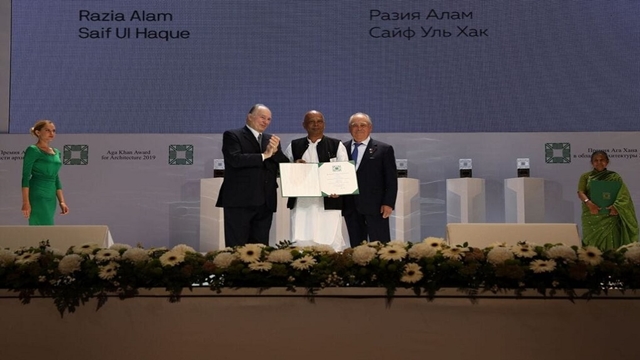FT Online
Published:2019-09-14 21:03:22 BdST
International experts praise Bangladesh's excellence in architecture
Leading members of the architectural community from around the world highly praised Bangladesh for its excellence in architecture as six winning projects of the 2019 Aga Khan Award for Architecture (AKAA) received their awards formally at a ceremony held at Musa Jalil State Academic Opera and Ballet Theatre here on Friday.
Mintimer Shaimiev, State Counsellor of the Republic of Tatarstan, accompanied His Highness the Aga Khan, hereditary Imam (spiritual leader) of the Ismaili Muslims, in presiding over the award ceremony.
The six projects to share a US$ 1 million prize, as selected by the 2019 Award Master Jury are Revitalisation of Muharraq, Bahrain, Arcadia Education Project, South Kanarchor, Bangladesh, Palestinian Museum, Birzeit, Palestine, Public Spaces Development Programme, Republic of Tatarstan, Russian Federation, Alioune Diop University Teaching and Research Unit, Bambey, Senegal and Wasit Wetland Centre, Sharjah, United Arab Emirates.
Saif Ul Haque and his client Razia Alam, Chairperson of Maleka Welfare Teust, were seen greeted by architects around the world before and after the formal award-giving ceremony.
Razia Alam first went to the stage followed by Saif Ul Haque amid claps from the huge audience making Bangladesh's presence well-felt everywhere at the venue.
"This is amazing," architect Aziza Chaouni who came from the University of Toronto, Canada told UNB appreciating Saif Ul's project and Bangladesh's demonstration in architectural scene.
Architect Ahmed Al Ali, one of the six project winners and Executive Chairman of X Architects, also appreciated Bangladesh's strong presence in architecture saying Bangladesh's architects keep doing amazing things.
The six Award recipients, spanning three continents, include an urban heritage intervention, a floating school, a national museum, an ambitious programme to introduce public spaces across hundreds of localities, a university’s classrooms and halls, and an ecological centre.
“You’re implementing the largest charitable, educational and humanitarian projects, support proactive, creative people, regardless of nationality or confession," said Mintimer Shaimiev acknowledging the contribution of His Highness.
“Your peacekeeping mission, your commitment to bringing civilisations closer and achieving unity in diversity are consonant with our goals, especially to me, as the Unesco Special Envoy for Intercultural Dialogue.”
Speaking at the ceremony, His Highness the Aga Khan noted that on this visit to Tatarstan, he had seen “how committed people can honour the power of both cultural identity and cultural pluralism.”
“It’s striking to see how churches and mosques, for example, have been built and preserved right next to one another as powerful symbols of a profound intercultural dialogue,” he said.
These were examples, the Aga Khan explained, of what the world was in particular need of today, as we seek to meet accelerating environmental, social, technological, economic and political challenges.
The award ceremony was attended by Eleonora Valentinovna Mitrofanova, the Ambassador-at-large of the Ministry of Foreign Affairs, other government officials, ambassadors and members of the international diplomatic corps, and leading members of the architectural community from around the world.
Speaking about the theme of “Architecture in Dialogue”, which emerged from this 14th cycle of the Award, the Aga Khan explained the potential of the architectural world to inspire and enrich creative dialogues, embracing diverse and even divergent perspectives.
“The rich architectural dialogue we seek to foster should include a renewed respect for the diversity of Islamic cultures themselves,” he said.
It was also necessary, he added, to foster a dialogue with non-Islamic cultures including diverse religious traditions.
“Architecture can lead the way in this effort – as we listen to one another and learn from one another across old divides.”
The Aga Khan went on to explain why the Ismaili Imamat was involved with architecture.
“The simple answer lies in my conviction that architecture -- more than any other art form -- has a profound impact on the quality of human life,” he said.

“I believe we all have a responsibility to improve the quality of life whenever and wherever the opportunity arises. Our commitment to influencing the quality of architecture – intellectually and materially – grows directly out of our commitment to improving the quality of human life.”
He said human challenges seem to intensify at an accelerating pace these days - climate change, economic and technological inequalities, epidemics, political polarisation, population displacements and the daunting task of helping one another to live together in dignity.
"I believe deeply in the potential of the architectural world to help inspire and enrich a creative dialogue in all four of the areas I’ve mentioned: a dialogue between creative architectural partners, a dialogue between past and future, a dialogue between natural reality and human creativity, and a dialogue among diverse cultures," he added.
On Thursday, the Aga Khan visited Bolgar, which was a Muslim religious centre as early as 922 and is renowned for its historic and archaeological significance.
He toured the Bolgar Islamic Academy, where he attended a special stamp cancellation ceremony to commemorate the Aga Khan Award for Architecture ceremony in Kazan.
Later in the day, he visited the White Mosque and the Bulgarian Civilisation Museum where he viewed one of the world’s largest Qurans.
The historical and archaeological complex at Bolgar has been designated as a Unesco heritage site.
Unauthorized use or reproduction of The Finance Today content for commercial purposes is strictly prohibited.


